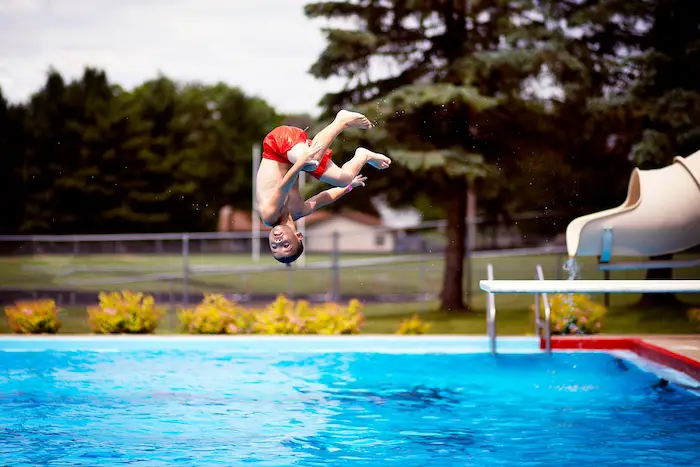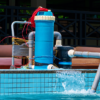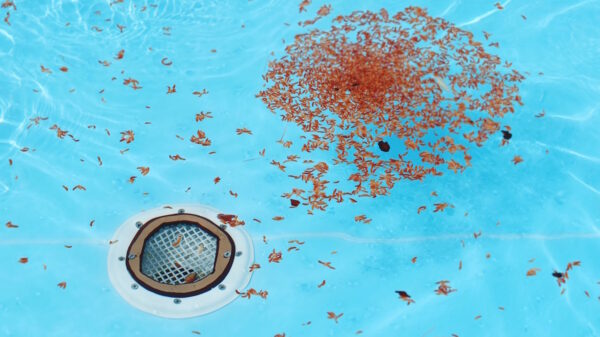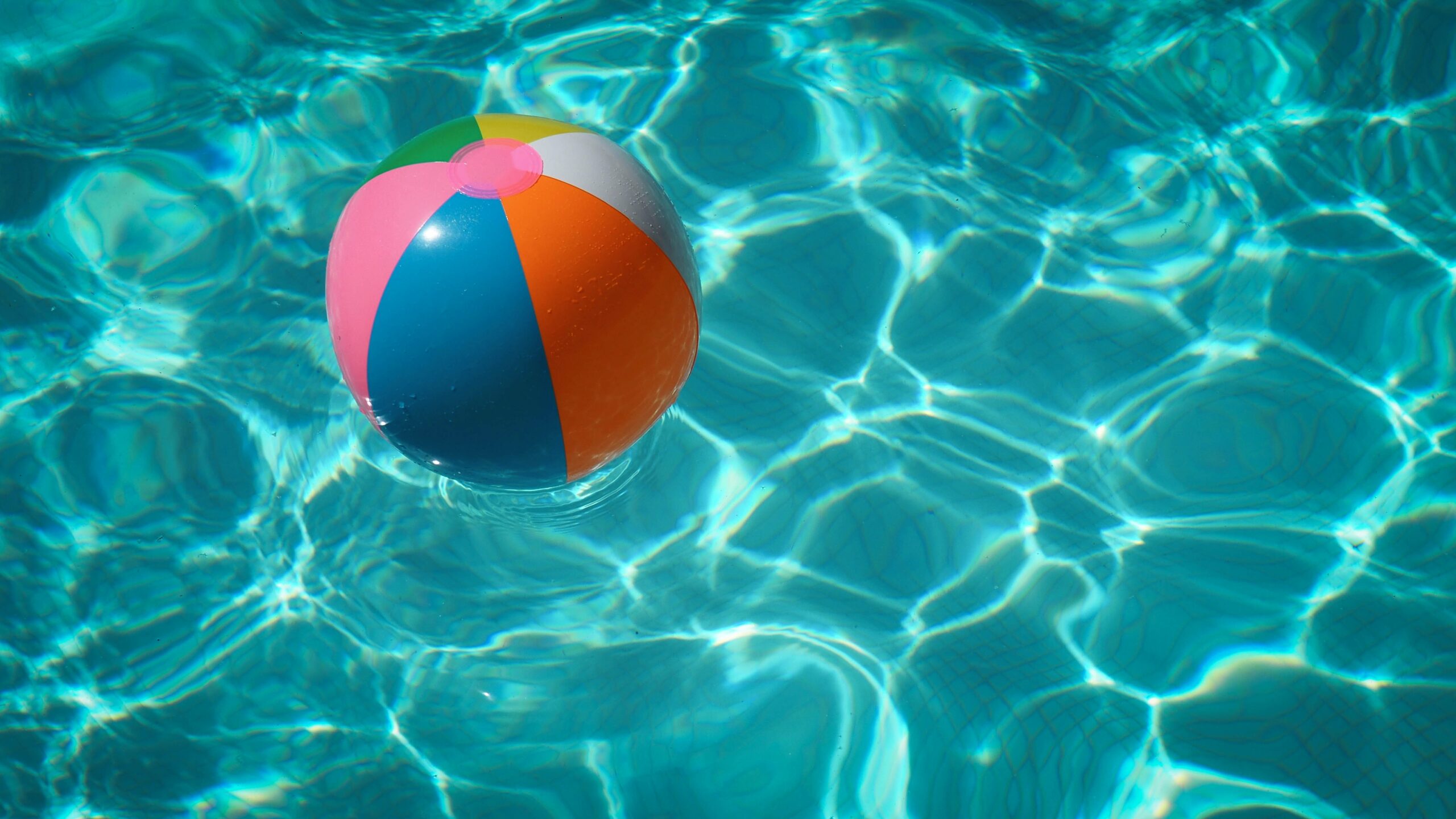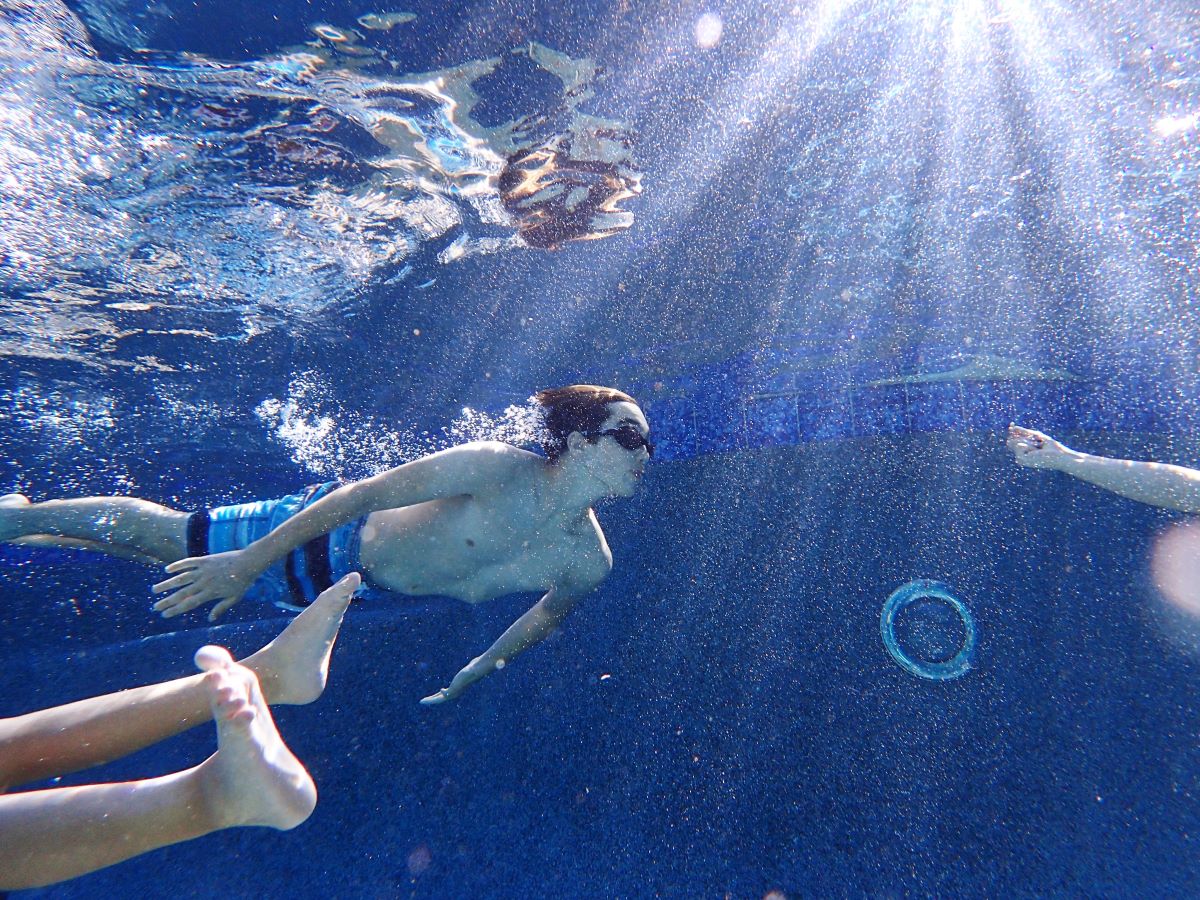Swimming Pool Tricks Are Aerial Acrobatics
Swimming pool tricks are aerial acrobatics performed in the water by a swimmer. Tricks consist of various techniques and moves performed above the surface, done without interruption. Because there is no depth involved with these tricks, it leaves more room for creativity and gravity-defying maneuvers. Some skill is required when performing most swimming pool tricks and always remember safety first!
There is not only one known creator for swimming pool acrobatics; however, most creators credit their roots to martial arts training or gymnastics. With the rise of social media platforms such as Facebook and Instagram, where anyone can go live on camera at any time, it has made a huge impact on the popularity of these types of videos being shared online.
It seems every day we see a new video posted by someone who just learned how to do that move in the water, or some sort of crazy triple flip with a twist. Swimming pool acrobatics are not easy to learn and often requires months for practice before even becoming somewhat decent at.
The sport of swimming pool tricks is also known as water-gymnastics, aquatic acrobatics or pool gymnastics. It involves a combination of tumbling, diving, somersaulting and flipping movements done in control without the help of equipment.
How Do You Get Started?
It’s important to note that you should learn how to swim first before attempting any of these tricks. I would recommend for anyone who wants to get started with swimming pool tricks start by learning some basic skills like riding the waves and doing flips under water. Riding waves will teach you how to do flips but they are more controlled on how far you can propel yourself from the surface. Once you have gotten used to riding the waves it’s time to move on to training for the underwater flips.
Training for Underwater Flips
Many of the swimming pool tricks are done underwater. There are techniques closely associated with being able to do a flip in water without it turning into what most people refer to as “the death-flip.” One of those methods is known as the explosive dolphin kick where you use rapid kicking and then pull back your head to extend your legs out of the water. While executing this method, you want to be sure that the first part of your movement is swift and focused around power rather than speed. When learning this type of kick make sure not to overstride because if you do, it will lead to exhaustion in no time at all.
The Most Popular
There is an innumerable amount of swimming pool tricks that have been created since they first began appearing on social media platforms over 10 years ago; however, there seems to be a handful that always stick out from the rest. The most popular aerial stunts include:
Front flip/flip
- This swimming pool trick has quite possibly become one of the most well-known types of acrobatics today. With its popularity, this maneuver has evolved into many variations including: double front flip, log roll , front flip with a twist, front flip with a spin, etc.
Front Somersault
- One of the first movements that is taught to beginner swimmers and often referred to as flipping or rolling in place. It is performed by kicking off the wall and using your body’s momentum to rotate around your centerline while holding your hands in front of you for balance and protection from impact on landing.
Front Pike Roll
- A forward roll on one hand while staying in plank position with your feet moving towards you and toward the bottom of the pool. Front pike rolls are also performed by standing on one arm.
Log Roll
- Consists of three moves that occur simultaneously: a half-flip, a spin, and a flutter kick. The trick finishes with a power gasp to exit out of the maneuver.
Spins/gainer flip
- An aerial stunt that involves spinning multiple times above water before landing back into it, while facing either direction. It is named after the person who came up with it, Gainus.
Whip kick
- A stunt in which a swimmer performing a flutter kick (left or right) rotates their body to either the left or right while underwater and gliding through water. The most common whip kick is the whip kick forward, where one does not come up for air before executing a straight leg flutter kick in front of them and hitting back into the water.
Flip-tuck
- This trick combines a front flip with an inward half turn into tuck position and ends by touching hands together above your head as you complete another half flip out of tuck position into normal freestyle position.
Buddha Roll
- A flip performed upside down that is based on the movement of a gymnast doing a somersault in mid-air with their legs together while their arms are extended outwards. It has become very popular within the diving community as divers attempt to showcase how flexible they are by performing a Buddha roll at tumbling competitions . At this point, there have been so many versions of this trick done that you can literally find one for nearly every different type of flip or dive, which makes it easy to remember what it’s called when someone asks you about it.
Front Paso Doble
- This move involves two flips and begins with a front pike roll in which your upper body goes across your lower body. There is also a back Paso Doble in which you go backwards across your lower body.
Canola(cannonball)
- This trick involves throwing yourself into the water without any pike or tuck, as a leaf would fall from a tree in the autumn. However, this move may be used with a power gasp at the end to exit out of it and create more distance/height (as seen in acro trick videos).
Corkscrew
- A series of somersaults that have been rotated 90 degrees clockwise while being timed so they are aligned with the wall before hitting it (like a corkscrew going into wine bottle), therefore making it look as if their head has disappeared into the wall and they have become “one” together.
Double whips
- A variation of whip kicks in which two whip kicks are done immediately after the other, while keeping flutter kicking your body up and down so that you are almost hitting the wall with your feet on different occasions. This is also called a double whip kick because one leg will be doing both whip kicks during it. Also a single whip involves doing only one whip kick at a time within one breath; there is no need to alternate legs as it is more meant for showing off that you can do multiple flips without using any air under water .
Homer Simpson
- An advanced trick where an aerial stunt is performed that rotates from 120 degrees (half way around) and back again while repeating a flutter kick in an alternative direction that is held during the somersault. It is named after the character from the television show The Simpsons because of his rotund figure, red hair and big teeth.
The Impulse
- An advanced trick where the swimmer performs a series of four to six whip kicks at normal speed before hitting into water with their glutes (buttocks) or kicking slower on purpose so they can create more height before hitting it .
Jawbreaker
- An aerial stunt in which one jump-turns underwater while doing a front flip and flipping your body under yourself in order to exit out of the mouth. Because this trick involves a front flip, it can be very dangerous if not done right and you are at risk for hitting the back of your head against the wall while coming up to come out of it (see: “danger”).
Kissing Fish
- This trick is an advanced jump turn involving a modified dolphin kick to make it look like one’s body has morphed into that of a fish. It is named after the phrase “kissing fish,” because of its similar appearance to kissing someone while they are in water .
The Loop
- An aerial stunt in which the swimmer performs several whip kicks before jumping-turning underwater in order that their lower body rotates 360 degrees around their upper body. It is named after the loop-de-loop rollercoaster because of its similar appearance to a roller coaster that has gone upside down .
Manatee
- A term used when describing an aerial stunt in which one performs several whip kicks before jumping-turning underwater in order that their lower body rotates 360 degrees around their upper body. The swimmer then opens their arms in order that they look like a manatee (a mammal related to the elephant and dugong), whose body is wider than it is long .
Monster
- An advanced trick where one jumps-turns off the wall on their side while performing several whip kicks at normal speed before hitting into water with their glutes (buttocks) or kicking slower on purpose so they can create more height before hitting it .
The Scooby Doo [aka: “the danger”]
- This term refers to an aerial stunt, usually performed by male swimmers, in which they turn upside down underwater with their feet close together and arms outstretched. It resembles the famous cartoon dog from Scooby Doo , who is known for running along with his tongue out.
The Whip
- A stunt in which one jumps-turns off the wall on their side while performing several whip kicks at normal speed before hitting into water with their glutes (buttocks) or kicking slower on purpose so they can create more height before hitting it .
Zombie
- An advanced flip turn where you start by doing a backflip off of the pool wall and then continue to do another backflip with your feet close together before hitting the water with your feet close together. This move is usually done underwater, but can be done outside of water. Because this trick involves a back flip, it can be very dangerous if not done right and you are at risk for hitting the back of your head against the wall while coming up to come out of it.
Swimming Pool Tricks Are Fun & Challenging!
At the end of the day, you’ve got to remember that swimming pool tricks are fun to do. And I don’t just mean they’re fun for yourself, but fun for your friends and family too! Make sure that you have a camera because there is nothing more entertaining than watching someone else make a fool of themselves…especially when it isn’t you!
Even though many of these stunts may seem impossible, there are a lot of swimmers online who have mastered them! Many people use websites like Youtube to find videos on how to do swimming pool tricks. You can search for specific trick tutorials or browse through their “most viewed” list in order to find the most popular ways to jump-turn and flip turn around.
So get in the pool, gather your courage, and dive in! An advanced trick that requires a lot of skill to do is always fun to attempt. And there’s no reason why you shouldn’t have the time of your life during your next trip to a swimming pool. So make sure that you come prepared with a towel because diving into something as cold as water can be dangerous if you don’t prepare yourself for it first!

